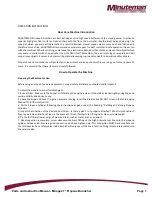
Parts and Instruction Manual -
Mirage 27” Propane Burnisher
Page 10
Air Exchange and CO Diffusion
- CO does not mix with air on its own. Air currents can stir the CO and dilute the
concentration values by mixing it with the available air. When using equipment over a large area in a short time
stirring occurs as you walk.
Application Considerations
When activity is concentrated to a smaller area as in a stripping application, air stirring
must be forced by use of fans to reduce the risk of high concentrations of CO.
Air Quality Monitoring
- Deployment of a monitor/detector is essential for the safe operation of any equipment
that has the potential to produce CO.
Room Size and Time Estimations
- The concentration and volume of CO production, the size of the area and the
amount of air exchange are factors involved with determining safe time limits for operation in a specific room size.
Maintenance of the Engine
- LPG powered engines are dependent on engine tune up, and air filter replacement.
CO concentration (production) rises exponentially when the air to propane ratio becomes propane rich. Follow the
recommended Maintenance Schedule for the engine.
Safety Equipment
- Three-way type catalytic converter to scrub CO, hydrocarbons (HC), and nitrous oxide (NOx)
from the engine exhaust providing the lowest possible emissions, high cubic feet per minute (CFM) fans (forced air
mixing), and digital combustion analyzers for tail pipe emissions monitoring.
The most reliable method to prevent CO Poisoning is to ensure the entire CO produced is vented outside.
With wood stoves or gas heaters this is performed with ductwork that carries the exhaust and CO outside. Non-
stationary combustion type equipment must be used in such a way that CO is not allowed to rise to a harmful or
dangerous level. CO does not readily dissipate or mix with air on its own. Air currents can stir the CO and dilute the
concentration or ppm values by mixing it with the available air. When using equipment over a large area in a short
time stirring occurs as you walk, or to say it another way, your effective operating zone is large. When activity is
concentrated to a smaller area as in a stripping application, the effective operating zone is small, and stirring must
be forced by the use of fans to increase the effective operating zone and reduce high concentrations of CO. Air
exchange rates (air exchange is defined as the exhausting of internal air to the external atmosphere), the size of the
effective operating zone, amount of CO produced, level of human activity, and the duration of exposure are all
factors in the determination of the production of carboxyhemoglobin and the amount of CO blood saturation.
AIR QUALITY MONITORING
Warning - Deployment of a monitor/detector is essential for the safe operation of any equipment that has the
potential to produce CO. CO sensors/detectors became available on the mass market around 1978. The main
differences between the technologies involved are battery or electric and Semiconductor or Biomimetic types.
Detectors for carbon monoxide (CO) are manufactured and marketed for use in either the home or occupational
industrial settings. The detectors for home use are devices that will sound an alarm before CO concentrations in the
home become hazardous. There is an Underwriters Laboratories, Inc., performance standard (UL 2034) for
residential CO detectors. Detectors currently available on the market are battery-powered, plug-in, or hardwired.
Some models incorporate a visual display of the parts per million (ppm) concentration of CO present in the home.
For more information on CO detectors for home use, call the Consumer Product Safety Commission: Commission
Hotline at 1-800-638-2772. CO detectors for use in residential settings are not designed for use in workplace settings.
Monitoring requirements in an occupational setting are different from monitoring requirements in the home. In the
workplace, it is frequently necessary to monitor a worker's exposure to carbon monoxide over an entire work shift
and determine the time-weighted average (TWA) concentration of the exposure. It may also be necessary to have
carbon monoxide monitors with alarm capabilities in the workplace.
Содержание Mirage 27"
Страница 1: ...Parts and Instruction Manual Mirage 27 Propane Burnisher ...
Страница 23: ...Parts and Instruction Manual Mirage 27 Propane Burnisher Page 16 ...
Страница 25: ...Parts and Instruction Manual Mirage 27 Propane Burnisher Page 18 ...
Страница 28: ...Parts and Instruction Manual Mirage 27 Propane Burnisher Page 21 ...
Страница 29: ...Parts and Instruction Manual Mirage 27 Propane Burnisher Page 22 Notes ...
















































